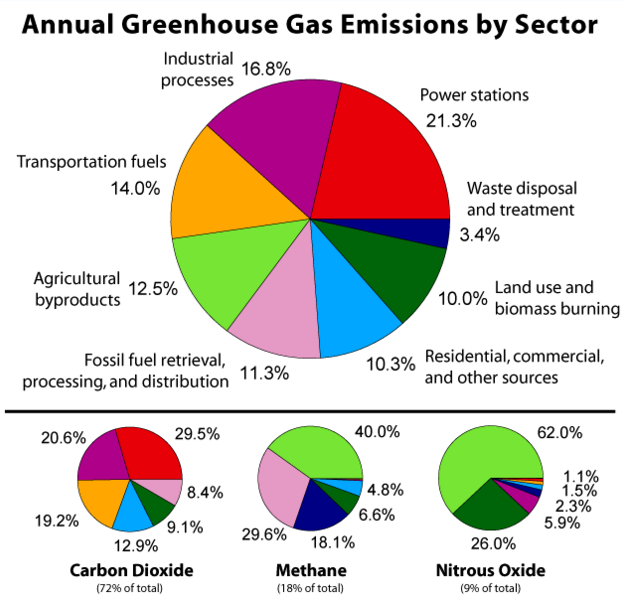The major greenhouse gases are water vapor, which causes about 36-70% of the greenhouse effect on Earth (not including clouds); carbon dioxide, which causes 9-26%; methane, which causes 4-9%, and ozone, which causes 3-7%. It is not possible to state that a certain gas causes a certain percentage of the greenhouse effect, because the influences of the various gases are not additive. (The higher ends of the ranges quoted are for the gas alone; the lower ends, for the gas counting overlaps.) Other greenhouse gases include, but are not limited to, nitrous oxide, sulfur hexafluoride, hydrofluorocarbons, perfluorocarbons and chlorofluorocarbons (see IPCC list of greenhouse gases).
Late 19th century scientists experimentally discovered that N2 and O2 did not absorb infrared radiation (called, at that time, "dark radiation") and that CO2 and many other gases did absorb such radiation. It was recognized in the early 20th century that the known major greenhouse gases in the atmosphere caused the earth's temperature to be higher than it would have been without the greenhouse gases.
Anthropogenic greenhouse gases
- burning of fossil fuels and deforestation leading to higher carbon dioxide concentrations;
- livestock and paddy rice farming, land use and wetland changes, pipeline losses, and covered vented landfill emissions leading to higher methane atmospheric concentrations. According to the Food and Agriculture Organization of the United Nations, the livestock industry is responsible for 18 percent of greenhouse gas emissions measured in CO2 equivalent, a higher share than transportation. Many of the newer style fully vented septic systems that enhance and target the fermentation process also are major sources of atmospheric methane;
- use of chlorofluorocarbons (CFCs) in refrigeration systems, and use of CFCs and halons in fire suppression systems and manufacturing processes.
- agricultural activities, including the use of fertilizers, that lead to higher nitrous oxide concentrations.
The seven sources of CO2 from fossil fuel combustion are (with percentage contributions for 2000-2004):
- Solid fuels (e.g. coal): 35%
- Liquid fuels (e.g. gasoline): 36%
- Gaseous fuels (e.g. natural gas): 20%
- Flaring gas industrially and at wells: <1%
- Cement production: 3%
- Non-fuel hydrocarbons: <1%
- The "international bunkers" of shipping and air transport not included in national inventories: 4%
Greenhouse gas emissions from industry, transportation (1/3 of total US global warming pollution) and agriculture are very likely the main cause of recently observed global warming. Major sources of an individual's GHG include home heating and cooling, electricity consumption, and transportation. Corresponding conservation measures are improving home building insulation, cellular shades, compact fluorescent lamps and choosing high miles per gallon vehicles.
Carbon dioxide, methane, nitrous oxide and three groups of fluorinated gases (sulfur hexafluoride, HFCs, and PFCs) are the major greenhouse gases and the subject of the Kyoto Protocol, which entered into force in 2005.
CFCs, although greenhouse gases, are regulated by the Montreal Protocol, which was motivated by CFCs' contribution to ozone depletion rather than by their contribution to global warming. Note that ozone depletion has only a minor role in greenhouse warming though the two processes often are confused in the popular media.
Image from Global Warming Art
This image is an original work created for Global Warming Art.
Permission is granted to copy, distribute and/or modify this image under either:
-
The GNU Free Documentation License Version 1.2; with no Invariant Sections, Front-Cover Texts, or Back-Cover Texts.
-
The Creative Commons Attribution-NonCommercial-ShareAlike License Version 2.5
Please refer to the image description page on Global Warming Art for more information
ttp://www.globalwarmingart.com/wiki/Image:Greenhouse_Gas_by_Sector.png











